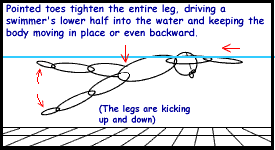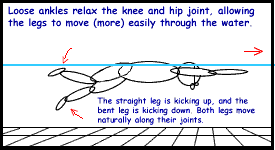Secrets of Air & Water
Breathing comes fairly naturally to most of us.
Wherever you are right now, do this:
Take a breath.
OK, so you’re a bit self-conscious, but that’s alright.
You probably didn’t draw in a big lungful or close your mouth after you breathed in, right? Exactly.
You usually inhale only what you need, whether you’re talking, walking around or eating lunch.
Your mouth is relaxed in order to do any of these things.
The first secret
Your air goes right to your lungs, not in your mouth.
Take a normal breath and hold it a moment.
Where is it NOT?
If you said to yourself, “My mouth?” you’d be right.
And that, gentle swimmer-to-be, is the secret.
Air goes right to your lungs, not stored in your mouth.
(You can exhale now!)
The second secret
There’s room for a breath only after exhaling the previous breath.
Take another breath and hold it in your lungs.
Don’t exhale.
Take in a bit more air, and now a teeny bit more.
Not so comfy, eh? Right. Now exhale everything through your mouth and nose.
It’s yet another secret, friends: There’s only enough room for your normal-sized breath after you fully exhale first.
How much do you each each time, anyway, if you’re breathing regularly? So.
This is the same principle used while swimming:
Every movement in the water supports constant, regular breathing. After all, the fun– and safe – aspect of swimming is to move through the water efficiently and comfortably.
This is what your pool lessons will teach you.
The truth
Let’s sum up:
- You always breathe the same way: right into your lungs.
- Your mouth, relaxed and even open while you swim, gets all the air you need, as you turn your face out of the water to breathe.
- Breathe as often as you need.
- You can have water in your mouth; your breath is safely in your lungs.
- Exhale each breath fully, out your mouth and nose, before inhaling.
- A relaxed mouth means a relaxed body… and a relaxed body will swim.
That’s all I’m here to tell you.
We won’t practice this fundamental fact in a pool.
(A promise is a promise.)
We will, however, try this safely at home…
Don’t fight the water
Here’s a 10-second review:
1. Take a normal breath, right down to your lungs and say out loud, “How’s this?” Keep holding your breath.
2. Wiggle your jaw, your shoulders and your toes. Notice where there’s tension, and relax that area. Still holding your breath, now.
3. Now go ahead and exhale through your mouth and nose.
By now you are surely noticing that you can hold your breath and relax your mouth at the same time. Nice work!
The paradox of water
Water quickly lets you know when you’re forcing it.
Water offers a lot of resistance; that’s why swimming is a superior workout.
To fight water is to misunderstand it.
Water quickly lets you know when you’re forcing it.
Relax when swimming and you will find both a natural watery resistance and an ease of movement.
Ah, such a paradox, like life itself…
Try this one at home
Hm – still not sure you can relax and yet move easily?
I promised you we’d stay away from a pool, but you can try this at home:
Take 5 steps on tiptoe. Now look down at your legs. Argh!
Wish I had a pool right now — I’d show you the difference between kicking the water with pointed toes (you don’t want pointed toes!) and the good stuff: kicking with relaxed toes, ankles, knees, and hips.
Here you are, standing on tiptoe. So you pointed your toes, and now your whole leg is tense and stiff. How do your hip joints feel? Yes, also stiff. Your hip is where your leg’s kicking motion originates. Point your toes, get a tight leg, and a stiff hip joint.

Now, try relaxing your ankle. Ahhhh…

Your knees and hip joints move freely, and you can really move through the water.
You’ll discover this for yourself in your future pool lessons, streamlining the basic movements shown in these (very!) simple illustrations.
Ready to add a little water?


